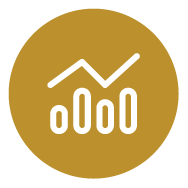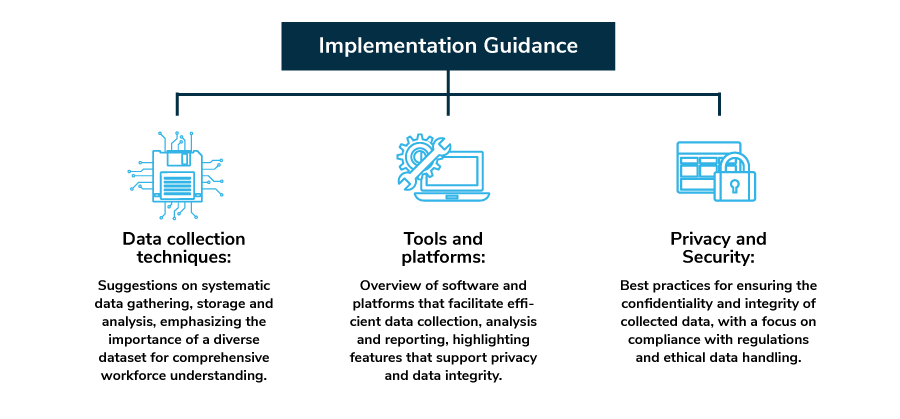April 12, 2024
Introduction
In our information-rich era, data stand out as a crucial – yet potentially underutilized – asset for any organization. To best leverage that asset, organizations can deploy a data strategy, a cornerstone of informed decision-making. In fact, Business Group on Health’s Workforce Data for Health and Well-being Programs survey1 revealed that 67% of employers surveyed recognize the need for a data-driven approach and have a data strategy in place (Figure 1).
Figure 1: Employer Data Strategy, 2023

Role of Data in Decision-Making
Increasingly, employers are leveraging data to develop an effective health and well-being strategy aligned with the organization’s holistic needs. A substantial number of employers recognize the critical role of data in shaping health care strategy and well-being decision-making processes.1 According to the survey, 93% of respondents consider data to be integral to health care strategy, and 81% believe it plays a crucial role in decisions related to well-being (Figure 2).
Figure 2: The Role of Data in Health Care and Well-being Strategy for Employers, 2023

By harnessing data, employers can identify prevalent health conditions and pinpoint leading cost drivers in the workforce. This approach allows for the development of targeted initiatives such as condition-specific approaches and solutions.2 Additionally, data-driven strategies enable organizations to drive engagement in well-being initiatives through communications delivered via preferred channels using relevant messaging, resulting in increased sustainable engagement and participation rates.3 These efforts align with the results in Figure 2, highlighting the need for robust data analytics capabilities in health care and well-being strategy decision-making.
Crafting a Wellness Data Blueprint: Paths for Employers to Smarter Health
Defining Your Health and Well-Being Data Strategy
The first step in data management is to set clear, specific objectives. Rather than a generic approach, a tailored data strategy is essential to meet the unique needs of the organization. This could involve custom reports that align with specific organizational goals, ensuring both the relevance and effectiveness of the strategy.
A strong data collection strategy goes beyond just one data source and includes a wide-spanning set of data points. Employers should aim to represent the diverse fabric of their workforce, capturing data from various segments, not just from the most engaged. Gathering a robust dataset, whether via a data warehouse or from vendor partners reports, is vital to provide a baseline understanding of the health and well-being issues affecting employees and their families and inform the prioritization of action areas. While a comprehensive dataset is ideal, starting with the most readily available data can establish a baseline and initiate meaningful action. It's important to take into consideration factors like location, job type and personal demographics, as well as cultural and geographical differences in large or global organizations.
Identifying Critical Data Points
To guide your data strategy, identify a selection of data types that could include:
-
 | Core Employee Information
| Core Employee Information
- Demographics: Age, gender, gender identity, marital status, geographic region, etc.
- Job-related demographics: Hourly vs. salary, exempt vs. non-exempt, salary band, job levels/titles, on-site vs. virtual vs. hybrid, etc.
- Coverage-related information: Health plan enrollment, dependent coverage, premiums, etc.
-
 | Health Plan Metrics
| Health Plan Metrics
- Cost: Per employee per month (PEPM) cost and trends, total cost of care (TCOC), medical claims cost, biosimilars, high-cost claimant insights, etc.
- Utilization: Member risk stratification, top diagnoses, chronic conditions, appropriateness of care utilization (such as access to primary care and emergency room utilization), etc.
- Quality and outcomes: Preventive care compliance, hospital admissions/readmissions, engagement with Centers of Excellence (COEs) vs. local care, virtual care, health care effectiveness data and information set (HEDIS) score, value-based features, etc.
- Care delivery: Access to primary care providers and hospitals by geography, access to COE for complex care, access to clinical trials, access to and utilization of virtual visits, out-of-pocket cost burden, etc.
-
 | Pharmacy Metrics
| Pharmacy Metrics
- Medication utilization: Prescription fill rates, medication adherence rates for chronic condition management and the generic fill rate.
- Overall cost and trend monitoring: Trends in average cost per prescription, (PEPM/Per Member Per Month (PMPM) trends, etc. Be sure to look at pharmacy data in the medical plan as well as the spending managed by the pharmacy benefit manager (PBM).
- Pharmacy spend: Source of rebates and performance against any guarantees in the contract with the vendor, etc.
- Pharmacy efficiency: Utilization of newly introduced drugs, volume and cost behind prior authorization process, rates of denial and opportunities to ease the burden of unnecessary prior authorizations on the patients and providers, etc.
- Patient engagement and satisfaction: Access to cost transparency and navigation tools, specialty medication engagement with supporting pharmacists, script refills, pharmacy service satisfaction, pharmacy communication satisfaction on medication shipment, etc.
-
 | Vendor Performance Metrics
| Vendor Performance Metrics
- Service quality: Net promoter score, response times, frequency of engagement, etc.
- Performance and outcome: Vendor reported return-on-investment (ROI), program utilization by targeted population, patient reported health improvement, etc.
-
 | Well-being Metrics
| Well-being Metrics
- Mental health: Employee assistance program (EAP) utilization, mental health claims, self-reported stress levels and utilization of mental health days or leave, etc.
- Physical health: Rates of preventive care utilization, biometric results, etc.
- Financial: Health savings account (HSA) and 401(k) contributions, percent of employees with a 401(k) emergency loan, etc.
- Social connectedness: Well-being champion involvement, frequency and nature of feedback, recognition programs, etc.
- Job satisfaction: Employee satisfaction surveys, employee engagement scores, etc.
-
 | Leave and Time Away
| Leave and Time Away
- Types of leave: Breakdown by leave type, frequency and duration of each leave type, etc.
- Cost: Cost per claim
- Duration and utilization: Leave duration, return-to-work rate, etc.
-
 | Additional Metrics
| Additional Metrics
- Ancillary benefit utilization: Utilization rates of ancillary benefits (e.g., dental, vision, disability, life insurance), trends in the selection of ancillary benefits by employees, etc.
- 1 | Customizable dashboards: Many analytics tools offer dashboards that can be customized to display key health and well-being metrics that matter most to each individual employer. These dashboards provide a clear, at-a-glance view of crucial data points such as employee engagement levels, program participation rates and health outcome trends.
- 2 | Automated reporting: Automated reporting capabilities are a common feature that include real-time or frequently updated data points, allowing employers to easily generate reports on various aspects of their well-being programs. These reports can include data on employee participation, program cost analysis and health outcome improvements.
- 3 | Survey and feedback tools: Survey and feedback tools are often part of these platforms, enabling employers to gather direct input from their employees about their health and well-being offerings. This feedback can be used to inform decisions about program modifications and enhancements.
- 4 | Benchmarking tools: Benchmarking capabilities within these platforms can compare an organization's data with industry standards or averages. This comparison helps employers understand how their programs compare to others and identify areas for improvement.
- Standardizing industry metrics: As more employers look to data as a means for advancing their health and well-being strategy, the priority in the near future is for the industry to establish a standard set of metrics that all vendors/partners can use to help employers monitor the success of their programs. Currently, the industry lacks consistent standards – from what is considered a true barometer of success to the units of measurement. This inconsistency prohibits the goal of interoperability between different vendors’ data feeds. A move to standardization is critical to advancing data strategy.
- Expanding data sources: There is an opportunity for employers to create a 360° view of employee well-being. They can do so by leveraging their partners to explore varied data sources, including not only data from vendors, health plans and other areas of HR/Benefits but also from health and fitness trackers and commercial databases. These additional sources can offer insights into consumer behavior and market trends, enriching the understanding of employee needs and preferences.
- Approaching big data with caution: Combining consumer-level data and employee data to create deeper insights may sound promising, but the reality may turn out differently. Employees and consumers may experience well-being and health care in different contexts. Additionally, while these external commercial sources offer insights, employees might be wary of how this data is collected and used from a “big brother” perspective. Employers might also have legal considerations to think about if they are gathering consumer data - even if it is publicly available data for purchase. Any integration of external datasets should be done so mindfully, with discrete objectives for its purpose.
- Enabling real-time data feeds: To provide a more accurate and timelier picture of employee health, there’s a need to shift from traditional weekly, monthly or quarterly reports to more frequent data updates. Real-time data feeds from vendor partners will inform employers with real time insights, allowing them to respond promptly to emerging health trends and needs.
- Predicting claims with Artificial Intelligence: Experts agree that one of most impactful areas of data management is predictive analytics. The ability to predict disease is still in its infancy but shows promise for early intervention to ward off costly and wasteful treatments. Along the same lines, Artificial Intelligence (AI) tools are a key part of predictive analytics, as they are able to wade through copious amounts of employee data to pinpoint individuals who are at risk for a disease or condition developing or advancing. By definition, AI will “learn” from these computing processes to optimize their predictions. As employers engage partners utilizing these tools, it will be important for employers to require full transparency into how the partners use the tools and with whom they share any data.
- From Benefits to Workforce Strategy: While a benefits data strategy is integral to making decisions about the design of various initiatives and the vendors who manage them, from the C-Suite’s perspective, the strategy may evolve. In time, there may be greater interest in bringing in other sources of data (beyond health and well-being) to inform a broader workforce strategy. For example, this evolution could include layering on diversity, equity, inclusion and belonging (DEIB) metrics and pulling in ways to assess the impact of environmental, social and corporate governance (ESG) initiatives. This movement isn’t necessarily additive – it’s about connecting leadership priorities to create a cohesive strategy.
- Global data strategy: For global employers, there will be an appetite to replicate successful data analysis strategies worldwide to pave the way for a globally consistent benefits experience. Setting sights on this approach won’t come without its challenges, including availability of data, privacy laws, internal accountability and maintaining clear data feeds, to name a few. Global employers should prepare for a growing demand for global health dashboards, emphasizing health equity and consistency in the employee experience worldwide.
Figure 3: Implementation Guidance, 2023

Ensuring Data Integrity and Security: Foundations for Effective Health Strategies
Data Ownership and Accountability
In the dynamic world of data, clear ownership is paramount. This step involves defining who is responsible for the data's accuracy, accessibility, consistency and completeness, ensuring its responsible and effective use in health and well-being initiatives. For the vast majority of employers who will not have a dedicated or in-house data team, securing data ownership and data validation rights via vendor contracting is a must. Reflecting on the importance of this approach, the Business Group’s survey1 found that employers are beginning to create a dedicated statistician or data scientist position on staff, with that individual tasked with managing workforce data and analytics.
Data Security and Compliance
In managing employees' sensitive health information, data security and privacy are crucial, necessitating a comprehensive and globally informed approach to comply with a spectrum of regulatory standards. Employers and their vendors should align their data storage and processing practices with laws such as the Health Insurance Portability and Accountability Act (HIPAA) in the U.S., the General Data Protection Regulation (GDPR) in the EU and the Personal Information Protection and Electronic Documents Act (PIPEDA) in Canada, among others relevant in different jurisdictions. Compliance involves enacting stringent security measures to safeguard data against unauthorized access and breaches, along with adopting practices that respect privacy through culturally sensitive consents, data anonymization and data minimization.
To navigate the complexities of varying international data protection laws, employers can undertake regular audits of their policies to ensure that they meet both local and international standards, especially when managing cross-border data transfers. Such transfers include strict adherence to laws governing international data transfers to protect data throughout its journey and at its final destination.
Beyond technical and legal compliance, establishing clear ownership and transparent management of data is critical. Employers can engage in transparent communication with employees about the use of their data, fostering an environment of trust. This involves not only one-time disclosures but also ongoing dialogue through internal newsletters, team meetings and accessible resources on the company intranet. Providing opportunities for employees to ask questions and express concerns is essential to demystify data practices and emphasize the organization's commitment to ethical data use.
Integrating these strategies—robust data protection measures, adherence to a broad spectrum of international laws, transparent communication, and ethical data management practices—underscores an organization's dedication to safeguarding personal health information. It's not just about fulfilling legal obligations; it's about cultivating a culture of trust and responsibility toward employees' data privacy and security in a complex, interconnected global landscape.
Data Storage Infrastructure
Sixty-eight percent of surveyed employers have a data warehouse, which further emphasizes the point that infrastructure is essential for consolidating various data sources, enabling more comprehensive and accurate analysis.1 This infrastructure is key to a more effective and centralized approach to data governance (Figure 4).
Figure 4: Breakdown of Employers Who Have Data Storage Options, 2023

Effective data life cycle management covers everything from data creation to its final disposition. This includes how data are collected, stored, used and eventually archived, ensuring the data's accuracy and availability for ongoing analysis.

Unlocking Insights Through Data for Enhanced Health Program Effectiveness
Data Analysis and Insights
The foundation of a robust data analysis strategy starts with the selection of analytics tools and technologies. Employers should seek platforms and partners that offer comprehensive data analysis capabilities, including predictive analytics and trend analysis. These tools can unveil patterns and insights hidden within large datasets, ranging from employee health trends to cost-effectiveness of different health programs. It's important to choose platforms that integrate seamlessly with multiple datasets, including existing HR systems, and ensure data privacy and security.
Current market offerings include user-friendly analytics platforms that provide essential data analysis capabilities without the need for extensive technical expertise.
These tools often feature:
Data Visualization and Reporting
Data visualization and reporting translate complex datasets into understandable and actionable insights. Employers should begin this step by determining the most significant data points to build a compelling narrative, which they should expect their data warehouse and consulting partners to assist with. Recognizing that each employer's objectives may vary, it is essential to tailor the selection of key metrics accordingly. Key metrics to consider include employee participation rates in well-being initiatives, the effectiveness of different health interventions and areas that require more focus on resources. Once the data points are identified and collected, employers can begin to construct their narrative by using data to support core messages they wish to convey.
Identifying the target audience of this reporting is the next step. This information guides the level of complexity in the presentation, informs impactful visualizations and determines the type(s) of data to include (comparative or longitudinal data, qualitative insights). Depending on the chosen communication method – reports, dashboards, emails or briefs – employers should utilize clear titles, consistent text hierarchy, meaningful and appropriate colors and effective charts and visuals to tell the story of their data to their audience.
Increasingly, organizations are adopting visualization approaches that improve accessibility. There are many tools that can support these efforts, such as confirming contrast color differentiation and color scheme accessibility for those who experience color blindness. Many customizable tools are available that provide intuitive dashboards and reporting features, highlighting the chosen data points. It is important to note that interactive dashboards suit technical audiences interested in a deeper data analysis, while static dashboards or reports are more appropriate for non-technical audiences who don't require detailed data exploration. Therefore, employers should opt for tools and vendor partners offering customizable reports catering to both types of audiences. A predetermined cadence of reporting is vital for tracking progress over time and aligning health and well-being initiatives with desired outcomes.

Data-Driven Decision-Making
The true value of data analysis lies in its ability to inform decision-making. Employers can cultivate a data-driven culture where decisions regarding health and well-being programs are based on empirical evidence combined with employee feedback. This involves continuously monitoring and analyzing data to identify what's working and what's not. For instance, if analysis reveals low engagement in a particular program, employers can investigate the underlying causes and adapt the program accordingly. Data-driven decision-making ensures that resources are allocated efficiently and that the health benefits offered are both relevant and effective for the workforce.
Collaborative Data Initiatives
Collaboration in data initiatives can significantly enhance the value derived from data analysis. Employers can consider partnering with external health experts, insurance providers and even other businesses to gain broader insights. Collaborative initiatives can provide benchmarking opportunities and facilitate the sharing of best practices in health and well-being management. Such collaborations can also lead to innovative approaches to common challenges in employee health and well-being.
The Findlay Model: A Blueprint for Employer-Led Health Care Improvement
A collaborative effort in Findlay, Ohio, brought together local employers, physicians and a hospital system to improve care and lower costs. By pooling data from employee health claims, the consortium, with the help of The Delta Group, analyzed treatment variations for conditions like hypertension and diabetes. This initiative led to targeted interventions, such as physician education on proper coding and the adoption of evidence-based guidelines, which resulted in significant cost savings and health improvements. For example, efforts focused on hypertension management led to a 25.5% reduction in combined costs of physician visits and hospital care from 2004 to 2007, with overall savings of $528,000 over 3 years.4
Evolving with Data: Building Resilience and Innovation in Health Strategy
Continuous Improvement
A mindset of continuous improvement is essential in the realm of data. Employers are well-positioned to require vendors and partners to keep employers abreast of new technologies and methodologies, allowing for regular refinement of data analysis practices. This process includes not only improving data collection and analysis processes but also being open to adjusting health and well-being programs based on new insights. Continuous improvement ensures that the employer’s approach to employee health remains dynamic, relevant and effective in an ever-changing business and health landscape.
Scalability and Future-Proofing
Scalability involves ensuring that the data management system can grow alongside the organization. This means the system must be capable of accommodating an increasing amount of data—such as personal information, employment records and health benefits data—from employees around the world. Furthermore, this effort includes more than just adding more storage; it also aims to ensure that the processes remain efficient and responsive as more team members are welcomed from different locations and countries. To future-proof operations, employers can focus on adopting flexible solutions that allow them to integrate new technologies and methods easily. This way, they can maintain high performance and efficiency, even as they transition from managing a workforce primarily in the U.S. to a diverse, global employee base. By prioritizing scalability, employers are preparing their organization to meet both current and future needs, ensuring a seamless experience for employees worldwide.

Outlook
The landscape of employee health and well-being data is rapidly evolving. Employers seeking to optimize their initiatives need to stay informed about upcoming trends. This includes the standardization of industry metrics, the exploration of new data sources and the cautious utilization of big data.
Charting the Future: Crafting a Dynamic and Durable Data Strategy
In the ever-evolving landscape of technology and data management, leading employers recognize that future-proofing their data strategy is a strategic imperative. This forward-thinking approach involves anticipating future technological shifts and organizational needs to ensure that today’s investments in data management systems continue to deliver value tomorrow. It goes beyond simply seeking short-term solutions; instead, it involves balancing a long-term vision with short-term needs when selecting partners and technologies. To achieve this, employers should steer clear of vendor lock-in scenarios that can hinder growth and flexibility and opt for an IT infrastructure that is not only robust and secure but also adaptable to change. Leading employers embrace tools, technologies and partnerships that can evolve with their organizations’ shifting needs.
Furthermore, maintaining stringent data governance and security practices is of the utmost importance, not only to safeguard sensitive information but also to ensure compliance with ever-changing regulatory standards. By adopting a proactive stance, continuously exploring new technological advancements, setting expectations with vendor partners and regularly revising their data management practices, employers can create a data strategy that’s not only effective today but remains resilient and relevant in the face of future challenges and opportunities.
Methodology
This study's findings synthesize data from five sources collected throughout 2023 using various methods. An online survey among 48 employer members of the Business Group ("Workforce Data for Health and Well-being Programs Quick Survey") was conducted between May 9 and 23, 2023. Additionally, qualitative interviews were conducted in Spring 2023 with five senior-level benefit consultants who specialize in strategic consulting and have in-depth knowledge about the changing workforce data landscape. Insights were also gleaned from employer-only sharing calls, where 54 employers participated in two roundtable discussions on data strategy and executive dashboards. Three employer presentations showcased success stories in utilizing data to enhance health and well-being offerings, while information shared on the Employer Community online discussion board, specifically focusing on metrics and dashboards, added further insights from over 10 employer posts.
Acknowledgements
The Business Group would like to thank those who contributed to this research. Their knowledge, experience and expertise made this qualitative research rich with unique insights, which will help create guidance for employers to consider when advancing their data strategies.
Citations
Before referring to or using this report in any way, you must receive permission from Business Group on Health. Please contact [email protected].
Suggested citation for this survey report:
Business Group on Health. Leveraging Workforce Data for Health and Well-being Programs: Guidance for Employers. April 2024. Available at: https://www.businessgrouphealth.org/resources/leveraging-workforce-data-for-health-and-well-being-success.
More Topics
Articles & Guides- 1 | Business Group on Health. Workforce Data for Health and Well-being Programs. June 13, 2023. https://www.businessgrouphealth.org/resources/workforce-data-for-health-and-well-being-programs. Accessed March 12, 2024.
- 2 | Mortenson P. How leveraging data can improve well-being. Corporate Wellness Magazine. https://www.corporatewellnessmagazine.com/article/leveraging-data-can-improve-well. Accessed March 10, 2024.
- 3 | Corporate Wellness Magazine. Data-Driven HR: Leveraging analytics for strategic decision making in 2024. https://www.corporatewellnessmagazine.com/article/data-driven-hr-leveraging-analytics-for-strategic-decision-making-in-2024. Accessed March 10, 2024.
- 4 | Klein S. Case study: Employers and providers work together to improve care, lower costs. The Commonwealth Fund. https://www.commonwealthfund.org/publications/newsletter-article/case-study-employers-and-providers-work-together-improve-care-lower. Accessed March 12, 2024.
This content is for members only. Already a member?
Login
![]()
